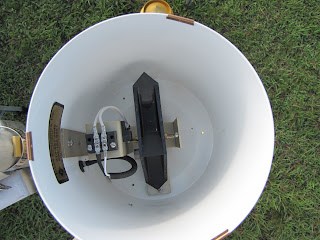Wednesday, October 27, 2010
Leave
Just an FYI that I will be on leave Oct 28-29. I will not be able to answer my cell phone. If you need to talk to me, send me an email and I will get back to you as I am able. Remember that we are meeting next Wed (Nov 3rd at 9am). Please take a moment to review the articles Isaya sent the group. Thanks Isaya!!
Tuesday, October 19, 2010
Dr. Richard Carey Publication
Please congratulate Dr. Carey on his latest publication. His manuscript entitled 'Nutrient Discharges to Biscayne Bay, Florida: Trends, Loads, and a Pollutant Index' was accepted for publication in Science of the Total Environment. This manuscript is part of his PhD dissertation work. Congratulations Dr. Carey!!
Graduate student meeting
Isaya, Tanh and Nicki - please remember we will meet tomorrow Oct 20th at 9am. I have sent you some materials to review for discussion. Please look through them so we can have a good meeting. Also - if you want to develop your CVs - you can send me drafts for input or exchange with each other.
Friday, October 8, 2010
Snapper Creek Project: an autumn tale

I have been in Homestead since early September focusing exclusively on the Snapper Creek Project - learning the different devices and troubleshooting some discrepancies in the systems. The following is a short summary of this project.
Project objective:
Erected this summer, the weather and soil water monitoring site at Snapper Creek (Miami, FL) is collecting data for use by water managers in Miami-Dade County to develop water and energy conservation measures for urban landscape irrigation systems.

Equipment installed at the site:
1. Wind speed sensor that measures accurately wind speeds in the range of 0 to 100 mph.
2. Temperature (-40o to + 60oC) and Relative Humidity (0 to 98% RH, non-condensing) probes.
3. Two Tipping bucket rain gages with 0.01 inches (0.254 mm) per tip.
4. Three Water content reflectometers to measure soil volumetric water content.
5. Two Soil temperature probes (-35o to + 50oC).
6. Precision Infrared radiometer (Field of view, 22o half angle).
7. Two Soil heat flux sensors (±2000 Wm-2).
8. Two Solar radiation sensors to measure incoming and reflected solar radiation.
9. Net radiometer.







Data collection:
Two Campbell Scientific data loggers (CR800 and CR1000) are used to collect the measured data. The PC400 software is used to download data from the data loggers.

Data Analysis:
To transform data into usable outputs (that include graphs) a program has been developed in VBA excel. This allows for data analysis almost immediately after downloading.

Observations:
· Generally the most sensors are recording weather data accurately. However, one rain gauge over estimates rainfall and a correction factor was developed for this particular rain gauge.

· The soil water content reflectometers underestimate the volumetric water content during unsaturated flow due to the existence of air pockets around the sensor rods. The accuracy of data collected was improved by reinstalling the water content reflectometers using a soil slurry made with sieved soil to minimize air pockets around the sensor rods.

Conclusion:
Data collection at the Snapper Creek site will continue for several years. Ideally, somewhat better understood thanks to what I was able to accomplish this past month.
Data collection at the Snapper Creek site will continue for several years. Ideally, somewhat better understood thanks to what I was able to accomplish this past month.

Nicholas Kiggundu
Tuesday, October 5, 2010
Graduate student meeting
Reminder that tomorrow at 9am is our grad student meeting. Please read the articles I sent you earlier. See you tomorrow!!
Friday, October 1, 2010
Once more, with feeling! Final WUEP research site is added.
This week I added a new research site to the urban landscape irrigation comparison study. Participating in Miami-Dade Extension’s Water-Use Efficiency Program (WUEP), the new site is only the second Homeowner’s Association (HOA) taking part in the research.

The system
The first retrofit phase occured in August, when the mechanical timer was replaced with the soil water sensor system and the TDT was buried in a sunny area under turf.



Thanks to the efficiency rebate the WUEP offers large HOA properties, we were able to install water meters on two irrigation zones during the second retrofit phase - upgrading from a six zone mechanical indexing valve to electric valves.





A water meter is installed on each experimental zone to monitor water-use and compare schedule-based to soil water sensor-based irrigation.





The system
The first retrofit phase occured in August, when the mechanical timer was replaced with the soil water sensor system and the TDT was buried in a sunny area under turf.



Thanks to the efficiency rebate the WUEP offers large HOA properties, we were able to install water meters on two irrigation zones during the second retrofit phase - upgrading from a six zone mechanical indexing valve to electric valves.





A water meter is installed on each experimental zone to monitor water-use and compare schedule-based to soil water sensor-based irrigation.

The end, but also the beginning
Undoubtedly the final research site installation of 2010, this property brings the site total to 15 for this year – this includes 10 complete retrofits and 5 meter installations on pre-existing digital systems.
Undoubtedly the final research site installation of 2010, this property brings the site total to 15 for this year – this includes 10 complete retrofits and 5 meter installations on pre-existing digital systems.


In the meantime, the 2011 WUEP is kicking into high gear. This means dozens of new properties across Miami-Dade County on board for irrigation system assessments, and my search for additional properties ideal for the pair-wise study renewed.

Subscribe to:
Posts (Atom)
